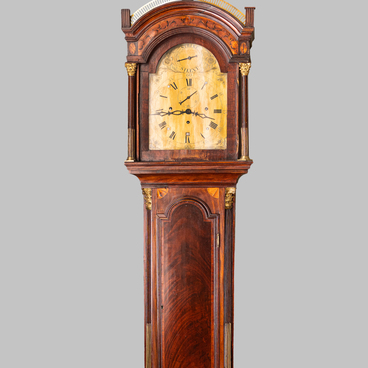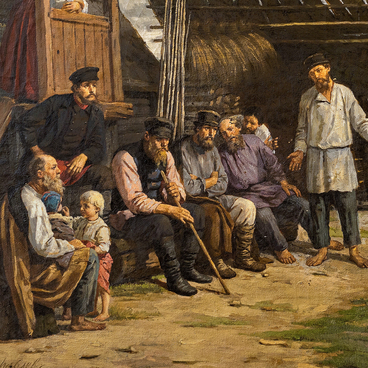The Volsk Museum of Local History houses a fragment of the Saratov meteorite. On October 6, 1918, it collapsed in a meteor shower within the boundaries of the Volsky, Petrovsky, and Bazarno-Karabulak districts.
This Saratov fragment belongs to the chondrite type. Chondrite is a stone meteorite, which includes chondrules — spherical or elliptical formations consisting mainly of silicates. The size of most chondrules is no more than a millimeter in diameter. Chondrites and the Sun have the same composition except for light gases — hydrogen and helium.
The circumstances of the Saratov meteorite fall have been well studied. The meteorite was moving from east to west from the Samara province. It flew over this area between four and six o’clock in the evening. The object was well-seen against the sunlight, leaving a double tail behind it.
During the fall, the meteorite split into three parts. The biggest one reached about 70 centimeters across and weighed 640 kilograms, it was found in the Volsk district. The second one reached a weight of about 480 kilograms and fell in the Petrovsky district. The third one, which landed near Hvalynsk, has not been found yet.
In September 1922, four years after the fall of the celestial body, a meteorite expedition led by mineralogist Leonid Kulik arrived in Saratov. His assistant Mikhail Minin wrote in the report, ’…The expedition spent almost two weeks in Saratov. During this time, they collected about half a dozen fragments of the Saratov meteor shower and also clarified information about the areas of its fall. In Saratov, people found out information about the fall of another meteorite near the Letyazhevka station in Balashovsky county. It happened, according to some sources, in 1917, and according to others — in 1919. The meteorite fell into a frozen lake and left a hole in the ice, with red powder all over it. Pavel Pilipenko, a well-known Saratov mineralogist, tried to find it earlier, but the search was unsuccessful
<…> went to Volsk. In the local scientific and pedagogical museum, the expedition received a fragment of a meteorite weighing 56 grams. <…>
The expedition found a meteorite the size of a chicken egg, which fell near a group of peasant children near the Mikhailevka village. The bolide sank a few centimeters into the ground. It was still warm when it was picked up and divided into fragments. After the Mikhailevka village, the expedition visited the village of Shakhovsky, where they also saw the fall of meteorite fragments. A local village teacher gave scientists a meteorite fragment weighing 150 grams.
After riding through Hvalynsky uyezd on horseback for about 200 versts, the expedition returned to Volsk. In the field, in the place where the meteorite fall, a few kilometers from the village of Donguz, Leonid Kulik collected about 50 small fragments with a total weight of about 220 grams <…> People found almost 200 fragments in the village of Belaya Gora.’
This Saratov fragment belongs to the chondrite type. Chondrite is a stone meteorite, which includes chondrules — spherical or elliptical formations consisting mainly of silicates. The size of most chondrules is no more than a millimeter in diameter. Chondrites and the Sun have the same composition except for light gases — hydrogen and helium.
The circumstances of the Saratov meteorite fall have been well studied. The meteorite was moving from east to west from the Samara province. It flew over this area between four and six o’clock in the evening. The object was well-seen against the sunlight, leaving a double tail behind it.
During the fall, the meteorite split into three parts. The biggest one reached about 70 centimeters across and weighed 640 kilograms, it was found in the Volsk district. The second one reached a weight of about 480 kilograms and fell in the Petrovsky district. The third one, which landed near Hvalynsk, has not been found yet.
In September 1922, four years after the fall of the celestial body, a meteorite expedition led by mineralogist Leonid Kulik arrived in Saratov. His assistant Mikhail Minin wrote in the report, ’…The expedition spent almost two weeks in Saratov. During this time, they collected about half a dozen fragments of the Saratov meteor shower and also clarified information about the areas of its fall. In Saratov, people found out information about the fall of another meteorite near the Letyazhevka station in Balashovsky county. It happened, according to some sources, in 1917, and according to others — in 1919. The meteorite fell into a frozen lake and left a hole in the ice, with red powder all over it. Pavel Pilipenko, a well-known Saratov mineralogist, tried to find it earlier, but the search was unsuccessful
<…> went to Volsk. In the local scientific and pedagogical museum, the expedition received a fragment of a meteorite weighing 56 grams. <…>
The expedition found a meteorite the size of a chicken egg, which fell near a group of peasant children near the Mikhailevka village. The bolide sank a few centimeters into the ground. It was still warm when it was picked up and divided into fragments. After the Mikhailevka village, the expedition visited the village of Shakhovsky, where they also saw the fall of meteorite fragments. A local village teacher gave scientists a meteorite fragment weighing 150 grams.
After riding through Hvalynsky uyezd on horseback for about 200 versts, the expedition returned to Volsk. In the field, in the place where the meteorite fall, a few kilometers from the village of Donguz, Leonid Kulik collected about 50 small fragments with a total weight of about 220 grams <…> People found almost 200 fragments in the village of Belaya Gora.’



